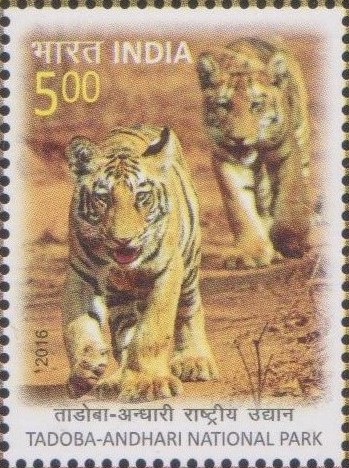
Tadoba Andhari National Park
A Miniature Sheet consisting of 2 nos. of commemorative postage stamp on the Tadoba Andhari Tiger Reserve (TATR), oldest and largest national park of Maharashtra :


 Issued by India
Issued by India
Issued on Jul 29, 2016
Issued for : Department of Posts is happy to release a set of two stamps on Tadoba Andhari National Park.
Credits :
Stamp / FDC / Cancellation Cachet : Smt. Nenu Gupta
Type : Miniature Sheet, Mint Condition
Colour : Multi Colour
Denomination : 500 & 2500 Paise
Stamps Printed : 0.3 million each
Miniature Sheet printed : 0.1 million
Printing Process : Wet Offset
Printer : Security Printing Press, Hyderabad
About :
- The Tadoba Andhari National Park and Tiger Reserve is one of the finest & largest National Parks in Maharashtra. It is an important Project Tiger Reserves in India. This beautiful natural area is situated close to Chandrapur District of Maharashtra. It was in 1955 when 116.55 sq. km. of the area was declared a National Park. Later, the Andhari Wildlife Sanctuary was created in the adjacent forests in 1986. In 1995, both the park and the sanctuary were merged to establish the present tiger reserve.
- The Tadoba Andhari National Park has an endless treasure trove of large number of species of trees & plants and wildlife like panthers, tigers, hyenas, sloth bears, wild dogs, jackals, barking deer, bison, sambar, to name a few. Overshadowed by teak & bamboo, and with a magical landscape of rugged cliffs, marshlands, lakes, etc., it has a large variety of flora and fauna, which makes it a popular tourist spot.
- The name ‘Tadoba’ is derived from the name of God “Tadoba” or “Taru”. The Gond kings were known to have once ruled the forests in the vicinity of the Chimur hills. It is believed that Taru was a village chief who was killed in a fierce encounter with a tiger and a shrine was built in his memory. The name “Andhari” is derived from the Andhari river which flows through the Park.
- The Andhari River, Erai Dam, Kolsa Lake, Junoria Lake and the Tadoba Lake form the lifeline of the park. The river and water storage systems provide year long supply of fresh water to this amazing ecosystem. Besides, small water bodies, rivulets and creeks also exist in the confines of the dense forests, in plains, and, in the hills. Man made water holes and small dams in the area add to the life sustaining environment. These factors explain the prolific bio diversity of the region.
- The vegetation of the forest is of Southern tropical dry deciduous type. Teak is the prominent tree species in the Tadoba forest. Besides teak, some other common trees found in the Park are Ain (Crocodile Bark), Bija, Dhaudab, Hald, Salai, Semal, Shisham, Mahua Madhuca (Crepe Myrtle) and Bamboo. In addition, Axlewood Anogeissus Latifolia, a fire-resistant species, is also found here, along with Buteamonosperma, which adds vivacious color to this forest. Arjun trees are also found at Panchadhara.
- A major part of this forest is in the hilly area of the Chimur Hills, and the Andhari sanctuary covers Moharali & Kolsa ranges. As a result, there are many hillocks and terrains which provide shelter to wild animals. Besides the species of Bengal Tiger, this park is home to other mammals like Sloth Bear, Leopard, Rusty Spotted Cat, Gaur (Indian Bison), Indian Mouse Deer, Ratel, Sambar, Wild Pig, Spotted Deer, Flying Squirrel, Four Horned Antelope, to name a few. As soon the night falls, the Small Indian Civet, the Palm Civet, the Ratel, and the Flying squirrel make their presence felt.
- Tadoba National Park is a popular tiger reserve that is popularly known as ‘The Land of Tigers‘ as large number of tigers are found here. The total area under the Project Tiger includes the core area and the buffer zone. The core area concept denotes critical tiger habitat, which is subject to intense conservation measures with minimal human intervention.
- Historically, the Bengal Tiger is known to have arrived in the Indian Subcontinent approximately 12,000 years ago. The Bengal tiger’s coat is yellow to light orange, with stripes ranging from dark brown to black; the belly and the interior parts of the limbs are white, and the tail is orange with black rings. The white tiger is a recessive mutant of the Bengal tiger, which is reported in the wild from time to time in Assam, Bengal, Bihar and especially from the former State of Rewa.
- Male Bengal tigers have an average total length of 270 to 310 cm (110 to 120 in) including the tail, while females measure 240 to 265 cm (94 to 104 in) on an average. The tail is typically 85 to 110 cm (33 to 43 in) long, and on an average, tigers are 90 to 110 cm (35 to 43 in) in height at the shoulders. The weight of males ranges from 180 to 258 kg (397 to 569 lb), while that of the females ranges from 100 to 160 kg (220 to 350 lb).
- Bengal tigers are territorial, and except for the core unit of mother and cub, they are solitary creatures. Each male tiger needs a large territory in which to hunt and mate. Once a Bengal establishes a home range, it usually sticks to it, and remains aware and respectful of other tiger’s ranges. However, due to rapid industrial development and continuing poaching activities during the last century, a sizable percentage of the tiger population, not only in India, but across the World, has been reducing substantially. At present the Bengal Tiger is listed under “Endangered” category in the IUCN (International Union for Conservation of Nature and Natural Resources) red list of threatened species.
- Tigers are a conservation dependent species. The Bengal tiger subspecies is at the top of the food chain in the wild. Tigers are also a vital link in maintaining the rich diversity of nature. When tigers are protected, we have so much more. For example, with just one tiger, we protect around 25,000 acres of forest. These ecosystems supply both nature and people with fresh water, food, and health.
- Text : Based on the material available on the internet.
Subscribe
Login
0 Comments







